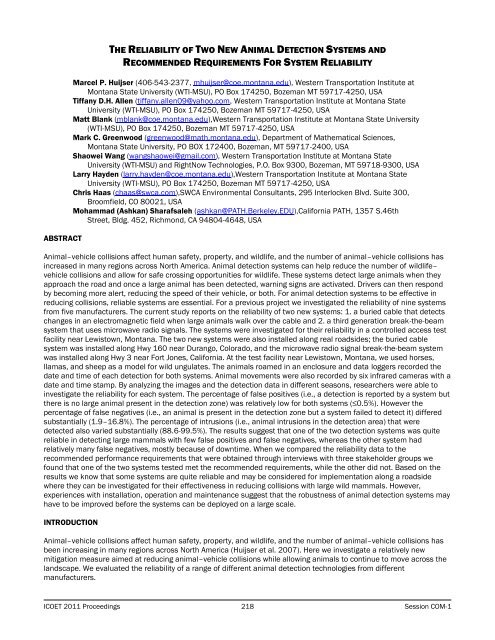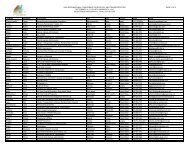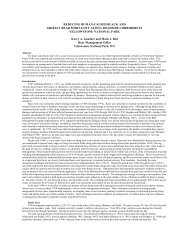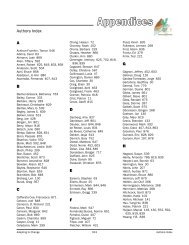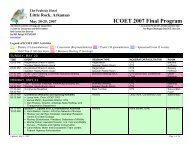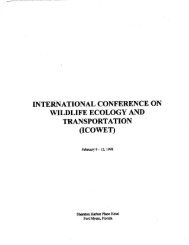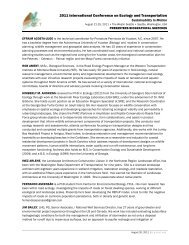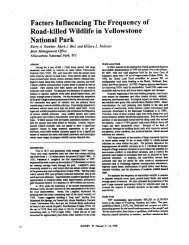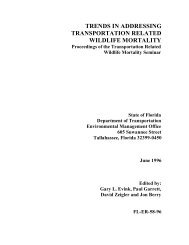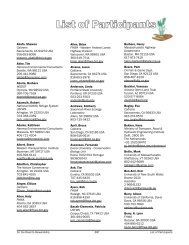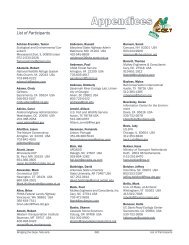COM-1, pages 179-226 - ICOET
COM-1, pages 179-226 - ICOET
COM-1, pages 179-226 - ICOET
You also want an ePaper? Increase the reach of your titles
YUMPU automatically turns print PDFs into web optimized ePapers that Google loves.
ABSTRACTTHE RELIABILITY OF TWO NEW ANIMAL DETECTION SYSTEMS ANDRE<strong>COM</strong>MENDED REQUIREMENTS FOR SYSTEM RELIABILITYMarcel P. Huijser (406-543-2377, mhuijser@coe.montana.edu), Western Transportation Institute atMontana State University (WTI-MSU), PO Box 174250, Bozeman MT 59717-4250, USATiffany D.H. Allen (tiffany.allen09@yahoo.com, Western Transportation Institute at Montana StateUniversity (WTI-MSU), PO Box 174250, Bozeman MT 59717-4250, USAMatt Blank (mblank@coe.montana.edu),Western Transportation Institute at Montana State University(WTI-MSU), PO Box 174250, Bozeman MT 59717-4250, USAMark C. Greenwood (greenwood@math.montana.edu), Department of Mathematical Sciences,Montana State University, PO BOX 172400, Bozeman, MT 59717-2400, USAShaowei Wang (wangshaowei@gmail.com), Western Transportation Institute at Montana StateUniversity (WTI-MSU) and RightNow Technologies, P.O. Box 9300, Bozeman, MT 59718-9300, USALarry Hayden (larry.hayden@coe.montana.edu),Western Transportation Institute at Montana StateUniversity (WTI-MSU), PO Box 174250, Bozeman MT 59717-4250, USAChris Haas (chaas@swca.com),SWCA Environmental Consultants, 295 Interlocken Blvd. Suite 300,Broomfield, CO 80021, USAMohammad (Ashkan) Sharafsaleh (ashkan@PATH.Berkeley.EDU),California PATH, 1357 S.46thStreet, Bldg. 452, Richmond, CA 94804-4648, USAAnimal–vehicle collisions affect human safety, property, and wildlife, and the number of animal–vehicle collisions hasincreased in many regions across North America. Animal detection systems can help reduce the number of wildlife–vehicle collisions and allow for safe crossing opportunities for wildlife. These systems detect large animals when theyapproach the road and once a large animal has been detected, warning signs are activated. Drivers can then respondby becoming more alert, reducing the speed of their vehicle, or both. For animal detection systems to be effective inreducing collisions, reliable systems are essential. For a previous project we investigated the reliability of nine systemsfrom five manufacturers. The current study reports on the reliability of two new systems: 1. a buried cable that detectschanges in an electromagnetic field when large animals walk over the cable and 2. a third generation break-the-beamsystem that uses microwave radio signals. The systems were investigated for their reliability in a controlled access testfacility near Lewistown, Montana. The two new systems were also installed along real roadsides; the buried cablesystem was installed along Hwy 160 near Durango, Colorado, and the microwave radio signal break-the-beam systemwas installed along Hwy 3 near Fort Jones, California. At the test facility near Lewistown, Montana, we used horses,llamas, and sheep as a model for wild ungulates. The animals roamed in an enclosure and data loggers recorded thedate and time of each detection for both systems. Animal movements were also recorded by six infrared cameras with adate and time stamp. By analyzing the images and the detection data in different seasons, researchers were able toinvestigate the reliability for each system. The percentage of false positives (i.e., a detection is reported by a system butthere is no large animal present in the detection zone) was relatively low for both systems (≤0.5%). However thepercentage of false negatives (i.e., an animal is present in the detection zone but a system failed to detect it) differedsubstantially (1.9–16.8%). The percentage of intrusions (i.e., animal intrusions in the detection area) that weredetected also varied substantially (88.6-99.5%). The results suggest that one of the two detection systems was quitereliable in detecting large mammals with few false positives and false negatives, whereas the other system hadrelatively many false negatives, mostly because of downtime. When we compared the reliability data to therecommended performance requirements that were obtained through interviews with three stakeholder groups wefound that one of the two systems tested met the recommended requirements, while the other did not. Based on theresults we know that some systems are quite reliable and may be considered for implementation along a roadsidewhere they can be investigated for their effectiveness in reducing collisions with large wild mammals. However,experiences with installation, operation and maintenance suggest that the robustness of animal detection systems mayhave to be improved before the systems can be deployed on a large scale.INTRODUCTIONAnimal–vehicle collisions affect human safety, property, and wildlife, and the number of animal–vehicle collisions hasbeen increasing in many regions across North America (Huijser et al. 2007). Here we investigate a relatively newmitigation measure aimed at reducing animal–vehicle collisions while allowing animals to continue to move across thelandscape. We evaluated the reliability of a range of different animal detection technologies from differentmanufacturers.<strong>ICOET</strong> 2011 Proceedings 218 Session <strong>COM</strong>-1


